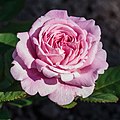
A rose is either a woody perennial flowering plant of the genus Rosa, in the family Rosaceae, or the flower it bears. There are over three hundred species and tens of thousands of cultivars. They form a group of plants that can be erect shrubs, climbing, or trailing, with stems that are often armed with sharp prickles. Their flowers vary in size and shape and are usually large and showy, in colours ranging from white through yellows and reds. Most species are native to Asia, with smaller numbers native to Europe, North America, and Northwest Africa. Species, cultivars and hybrids are all widely grown for their beauty and often are fragrant. Roses have acquired cultural significance in many societies. Rose plants range in size from compact, miniature roses to climbers that can reach seven meters in height. Different species hybridize easily, and this has been used in the development of the wide range of garden roses.

Rosa 'Ispahan', also known as 'Rose d'Ispahan' and 'Pompon des Princes', is a clear pink, half-open kind of Damask rose, a type of garden rose introduced from the Middle East to Europe during the crusading 13th century.

Rosa'Violet Carson' is a salmon-pink rose cultivar, an uncommon hybrid of the red hybrid tea 'Mme Léon Cuny' and the orange floribunda 'Spartan', created by Samuel McGredy IV between 1963 and 1964. It was named after the English actress Violet Carson (1898–1983), who played Ena Sharples in the British soap opera Coronation Street.

Rosa 'American Beauty' is a deep pink to crimson rose cultivar, bred by Henri Lédéchaux in France in 1875, and was originally named 'Madame Ferdinand Jamin'.
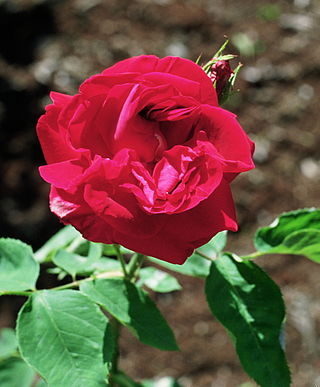
Rosa 'Général Jacqueminot', also called 'General Jack' or 'Jack Rose', is an early Hybrid Perpetual rose cultivar, developed by Roussel, an amateur from Meudon, and introduced by the gardener Rousselet in 1853. The flower was named in honor of Jean-François Jacqueminot (1787-1865), a French general of the Napoleonic Wars. Its parentage is unclear, but 'Gloire des Rosomanes' and 'Géant des Batailles' are considered probable ancestors.

Rosa'Double Delight',, is a multiple award-winning, red blend hybrid tea rose cultivar bred in the United States by Swim & Ellis and introduced in 1977. Its parents were two hybrid tea cultivars, the red and yellow 'Granada' and the ivory 'Garden Party'.

Rosa 'Eden' is a light pink and white climbing rose. The cultivar was created by Marie-Louise Meilland and introduced in France by Meilland International in 1985 as part of the Renaissance® Collection. It was named 'Pierre de Ronsard', after the French Renaissance poet Pierre de Ronsard in reference to his famous ode that begins: Mignonne, allons voir si la rose for the 400th death anniversary celebrations of the poet. The cultivar is also called 'Eden Rose 85' as Meilland had already introduced a rose cultivar called 'Eden' in the 1950s.

Garden roses are predominantly hybrid roses that are grown as ornamental plants in private or public gardens. They are one of the most popular and widely cultivated groups of flowering plants, especially in temperate climates. An enormous number of garden cultivars has been produced, especially over the last two centuries, though roses have been known in the garden for millennia beforehand. While most garden roses are grown for their flowers, often in dedicated rose gardens, some are also valued for other reasons, such as having ornamental fruit, providing ground cover, or for hedging.

Rosa 'Nevada' is a white climbing rose cultivar developed by Pedro Dot in Spain in 1927. It is one of his most successful creations and is named for its colour, as nevada is the Spanish word for "snowy". Its parentage was long under discussion, as Dot introduced the cultivar as a hybrid moyesii, but the cultivar's round, black hips point to its R. pimpinellifolia-parentage. It is probably a cross between Dot's pink hybrid tea 'La Giralda' and the wild rose species Rosa pimpinellifolia var. altaica, but is sometimes still described as a hybrid moyesii.
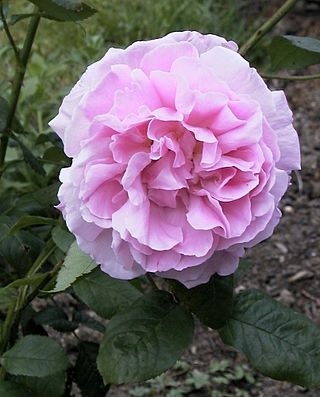
Rosa 'Wife of Bath', is a pink shrub rose cultivar developed by David C.H. Austin in England in 1969. It was one of his early cultivars and is named after a character from Geoffrey Chaucer's The Canterbury Tales. 'Rosarium Glücksburg' is a rose garden in the park of Schloss Glücksburg in Glücksburg, Germany.

Rosa 'Duchess of Cornwall' is an orange blend rose cultivar bred by Hans Jürgen Evers from Rosen Tantau in Germany and introduced in 2005. The nostalgic hybrid tea rose is known as 'Music Hall' in France, and as 'Chippendale' in Germany. According to Robert Markley, it is already one of Tantau's most successful roses.

Rosa 'Cécile Brünner', also known as 'Mlle Cécile Brünner', 'Sweetheart Rose', 'Malteser Rose', or 'Mignon', is a light pink polyantha rose bred in France by Marie Ducher and introduced by her son-in-law, Joseph Pernet-Ducher in 1881. Its parents were a double-flowered R. multiflora and a hybrid tea rose, either 'Souvenir d'un Ami' or a seedling of 'Mme de Tartas'. It is not clear if the rose was named after the sister (1853–1927) or daughter of Ulrich Brunner fils.

Rosa 'Blush Noisette' is a light pink Noisette rose introduced by Phillipe Noisette around 1815. It was one of the first Noisette roses, and over time has been called by a multitude of names, including Rosa × noisettiana, 'Rosier de Philippe Noisette', 'Noisette de l'Inde, 'Blush Cluster', or 'Noisette Carnée'. According to the RHS Encyclopedia of Roses, the cultivar is mostly called 'Blush Noisette' in America, and otherwise known as 'Noisette Carnée'. 'Blush Noisette' arose as a seedling from the light pink rose hybrid 'Champney's Pink Cluster', introduced by Champneys around 1811, and was the first frost-hardy climber flowering repeatedly, giving the cultivar importance as a parent rose.
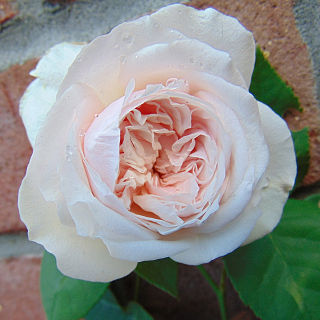
Rosa'Souvenir de la Malmaison' is a rose cultivar with large, very pale pink flowers that open flat. The Bourbon rose was created in 1843 by Lyon rose breeder Jean Béluze, who named it after the Château de Malmaison, where Joséphine de Beauharnais (1763–1814) had created a magnificent rose garden. It is probably a cross between 'Mme Desprez' and 'Devoniensis'.
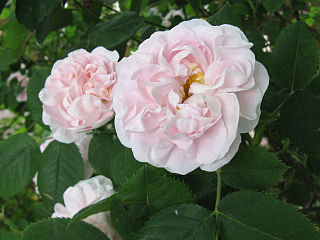
Rosa 'Great Maiden's Blush' is white blend Alba rose cultivar that appeared during the 14th century. It was introduced in Australia by Camden Park in 1843 as 'Maiden's Blush'. 'Great Maiden's Blush' has received the Royal Horticultural Society's Award of Garden Merit, and the American Rose Society's Dowager Queen award at the Syracuse Rose Society show.

Rosa × odorata or Rosa odorata is a hybrid flowering plant of the genus Rosa native to Yunnan in southwest China, whose taxonomy has been confused. It has been considered a hybrid of Rosa gigantea and Rosa chinensis, or as a quite rare wild species that includes R. gigantea. The wild forms are cultivated to some extent. Cultivars were developed in China in ancient times from R. chinensis crosses, and these have been important in the ancestry of the tea-scented China roses, also called tea roses, and their descendants the hybrid tea roses.
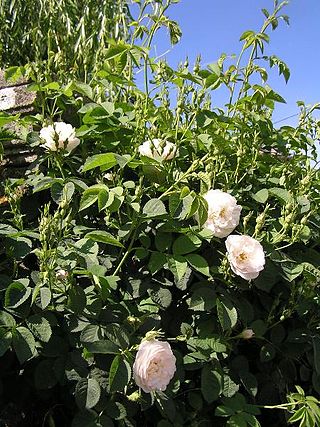
Rosa × alba, the white rose of York, is a hybrid rose of unknown parentage that has been cultivated in Europe since ancient times. It may have originally been grown mainly for the sweet scent of the flowers, but is now also used as a winter-hardy garden shrub. Cultivated forms have white or pink flowers, and most have many petals. Hybrid cultivars have also been produced with red or yellow flowers.
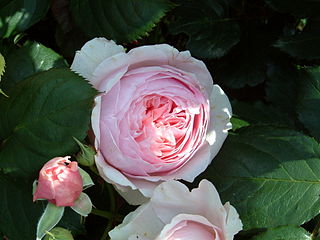
Rosa'Constance Spry' is a light pink shrub rose introduced into Great Britain in 1961. It is the first rose cultivar commercially developed by British rose breeder, David C.H. Austin. 'Constance Spry' was introduced at a time when the shrub rose was out of style, the hybrid tea rose being the most popular rose with gardeners. The new cultivar renewed the popularity of the more old fashioned type of rose.

Rosa 'Baroness Rothchild' is a pink Hybrid Perpetual rose cultivar, bred by Jean Pernet in 1868 and introduced in Australia by St. Kilda Nurseries in 1873 as 'Baroness Rothschild'.

Rosa 'Compassion' is a pink-blend climbing rose cultivar developed by Jack Harkness and introduced into Great Britain in 1972. It is considered to be one of the best modern climbers and is a popular selling rose in Britain.





















